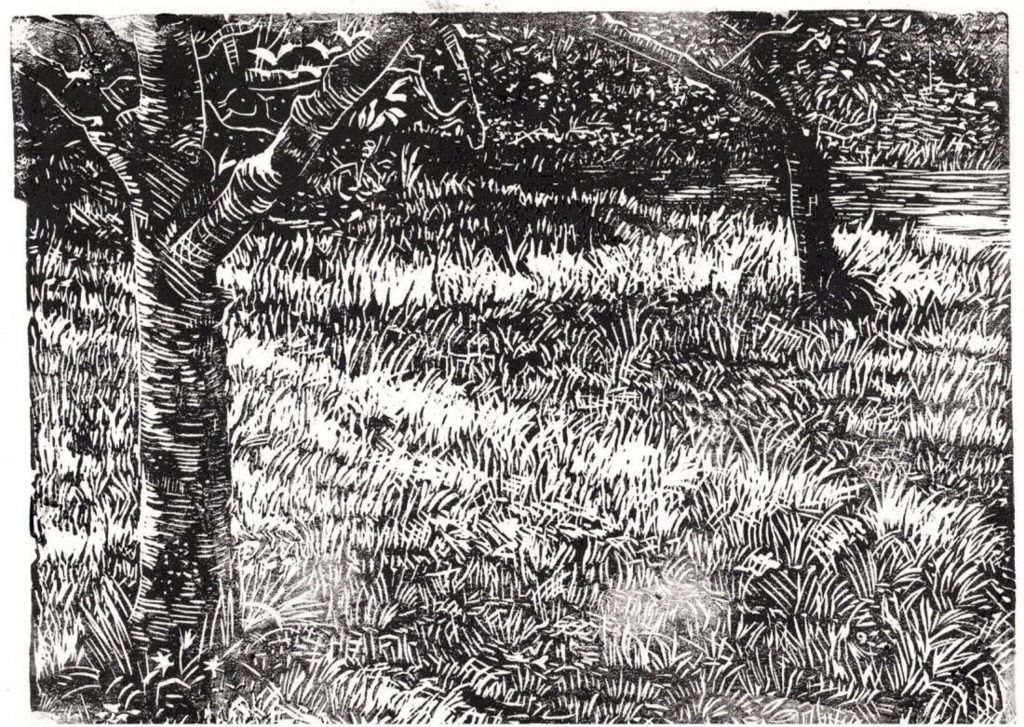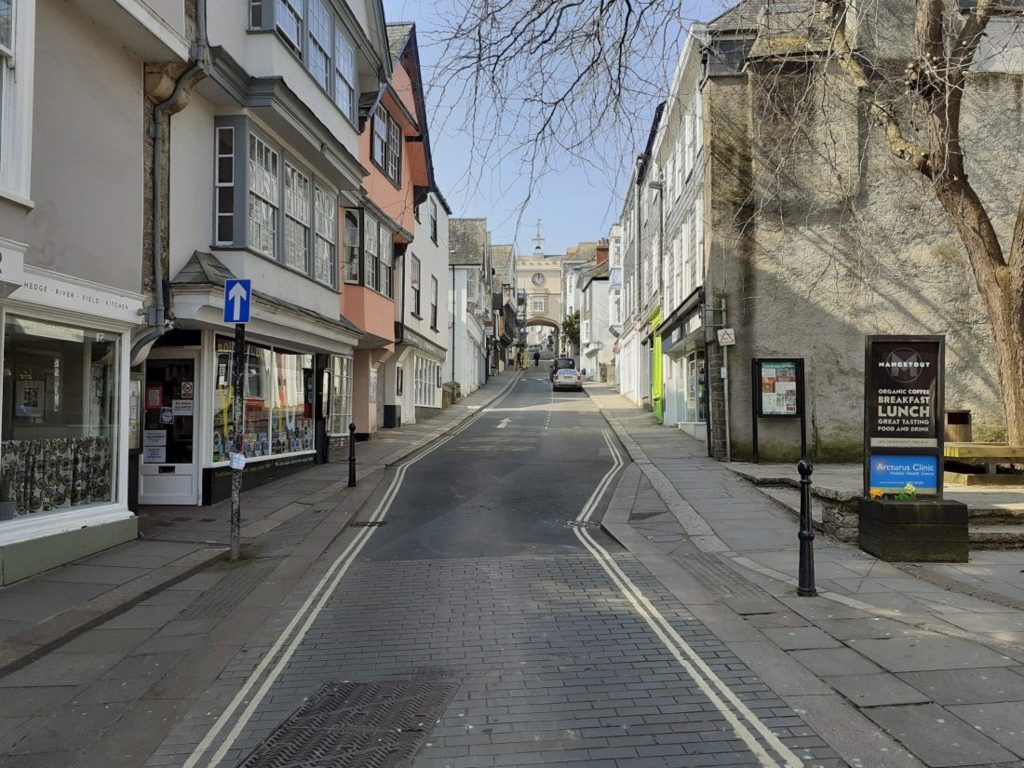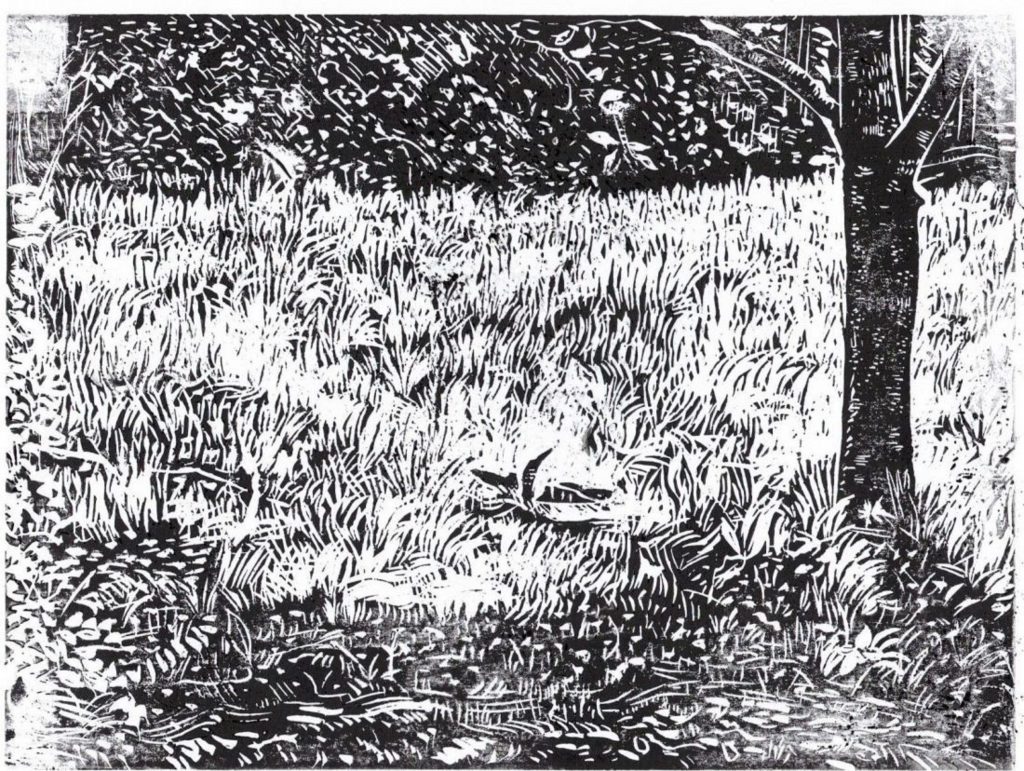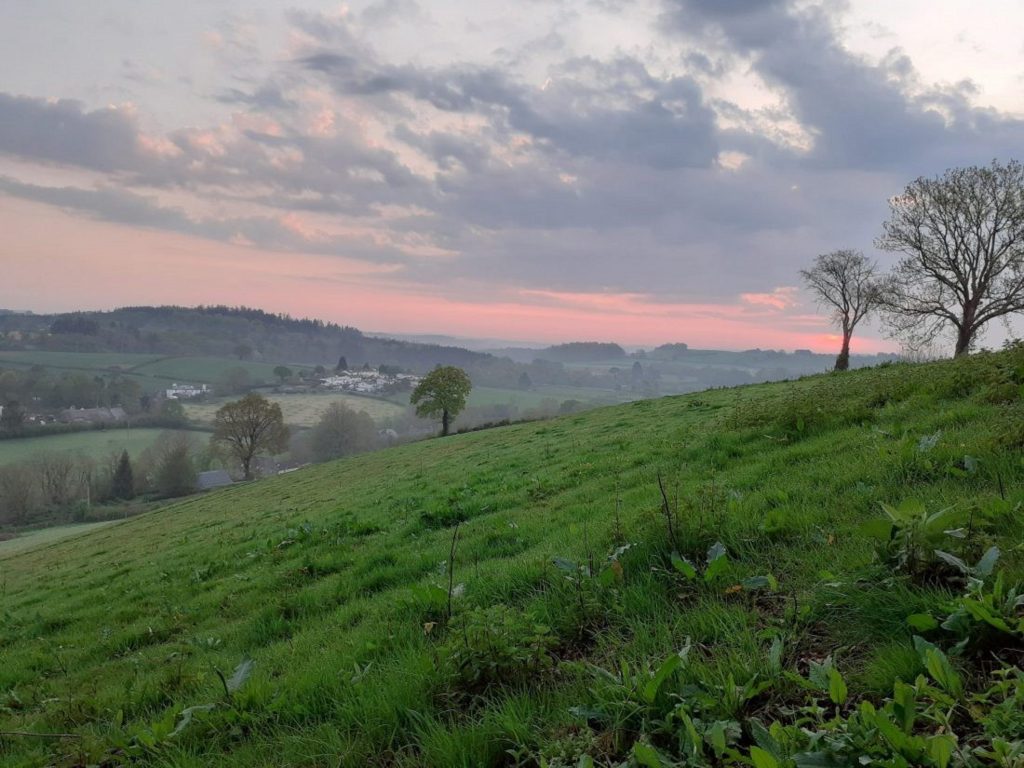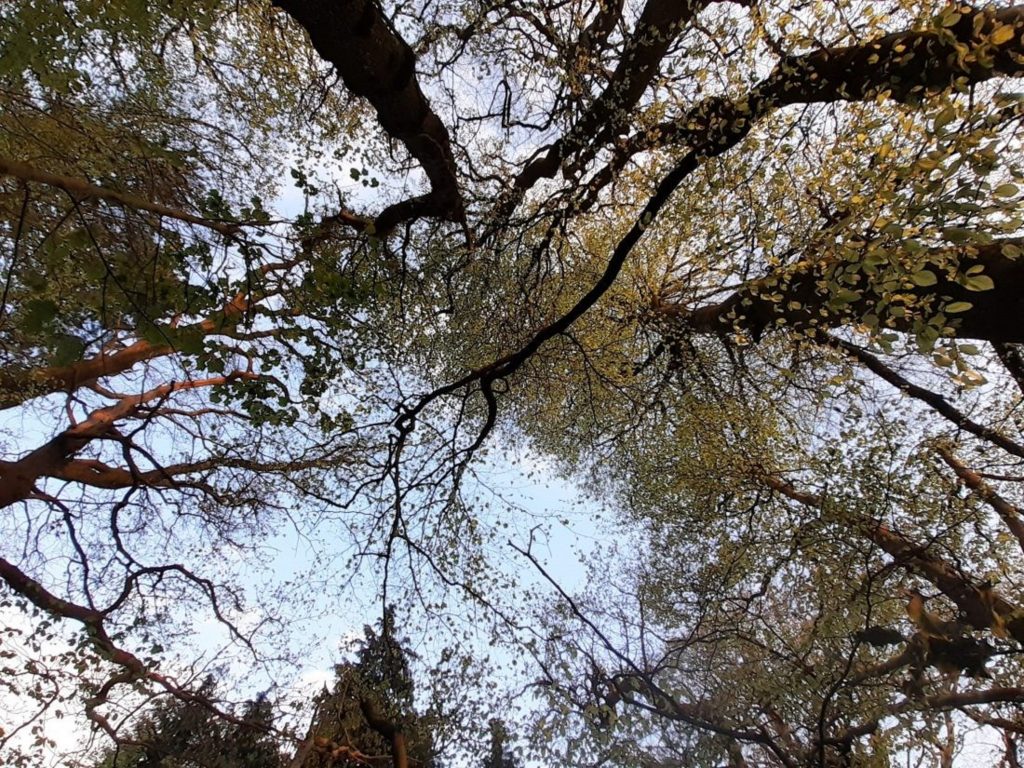“The sun will never shine as it does today” –
Some Reflections from Lockdown
Rob Hopkins © 2020
These days of the coronavirus lockdown have been, to paraphrase Charles Dickens, the best of times, and the worst of times. My intention in this piece isn’t to share my thoughts on what should come next, on how society might be rebuilt following all of this. Rather I want to give you a snapshot of what these days look like and feel like where I am. To record for posterity how these extraordinary days were lived and experienced through my own eyes. A couple of pages torn, if you like, from a diary to give a flavour of one person’s experience of living through these momentous times.
For a bit of background, I live near Totnes, in Devon, in the south west of the UK. I live in a small suburban cul-de-sac, with fields and woods a close walk away. I acknowledge my privilege in living outside the large conurbations and having a livelihood that means I am, in effect, on a pause. I am fortunate enough to have garden space to grow food. I am locked down here with my wife, Emma, and 3 of my 4 sons, aged 18, 20 and 23. When the lockdown was announced, about 4 months of work, bookings I had to travel and speak in different places, disappeared overnight. Some of my work moved online, much of it vanished.
I note how different reality under lockdown is from what I had planned. I went into it with a pile of very important, very smart books to read about psychology and politics and economics, books I felt that now, finally, was the time to read. In reality, I re-read my favourite book about Van Gogh, Martin Gayford’s The Yellow House: Van Gogh, Gauguin, and Nine Turbulent Weeks in Arles, Jon Savage’s This Searing Light, the Sun and Everything Else: Joy Division: The Oral History, and one of my favourite old novels, Klingsor’s Last Summer by Hermann Hesse as well as looking at lots of art books. Some of the jobs I planned to do got done, some remain on the ‘to do’ list. My garage never looked so tidy.
While you may know me as that Transition fella, you may be less aware that I studied art at college when I was 18, and have tried, in spite of being very busy with Transition, raising a family and so on, to keep that part of me alive over the years. One thing I have striven to achieve during this lockdown has been taking the opportunity to make art-making a daily part of my life. And the world around me has responded by putting on the most spectacularly beautiful Spring of my life.
I don’t know if it’s that this Spring actually is more vibrant, ecstatic, dazzling and delicious than any I can recall, or if it’s just that I have had more time to experience it, more time and attention span to dedicate to it, but these sunshine-saturated days as tree leaf buds explode like fireworks in a wild symphony of greens, oranges and browns against the deep blue sky, have left me breathless. I find myself wanting to spend all my time outdoors trying to capture the light, the shade, the patterns, the swirls. I recently rediscovered the medium of linocutting, and it is a beautiful monochrome medium for trying to capture the pulsating brightness and the accompanying shadows.
Hesse’s Klingsor’s Last Summer tells the story of a painter living the last summer of his life with ‘hectic intensity’, wanting to capture and paint everything and not miss a moment. In one passage, Hesse writes:
“This day will never come again and anyone who fails to eat and drink and taste and smell it will never have it offered to him again in all eternity. The sun will never shine as it does today…But you must play your part and sing a song, one of your best. ”
I’ve felt like that. I remembered Tony Whitehead, the ornithologist who introduced me to the dawn chorus a couple of years ago, saying “you only get so many Mays in your life” (May being the month when the dawn chorus is at its most intense). I wonder if we will look back on the days of the coronavirus lockdown as having been, in part, the most exquisite Spring, one we soaked up every taste and smell of, or else one that passed us by, either because we were too busy and overwhelmed, or because Netflix and Fortnite called to us louder than the world outside our windows.
William Gibson once wrote “the future is already here – it’s just not evenly distributed”, and coronavirus is the same. In my house, it feels like an extended, albeit rather surreal, holiday, while my next-door neighbours, both key NHS workers, are trying to juggle their work, two small children and the restricted realities of daily life. And two doors further down, a neighbour is ill with the virus. Best of times, worst of times.
One evening, Emma and I walk the dog, in the near hallucinatory blur of evening sunshine. We meet a friend, and we discuss how surreal walking around in the town of Totnes is right now, with most shops closed, hardly anyone around, very few cars. I mention my favourite sign I’d seen in a shop window on my last visit there, ‘Panic buying welcome’. I fear that our high street, so rare in the UK today with it’s 80 locally-owned businesses, will look very different once this is all over.
The empty streets of Totnes.
As we head across a field with the dog, a chorus of whooping, applauding, banging of pots and pans starts up. It has become a weekly fixture at 8pm on Thursdays in support of the NHS and other key workers. It ripples across the housing estates that adjoin the field. It sounds like one house has brought out its sound system and started to play disco. We applaud and holler our support as a murmuration of starlings (I always wanted an excuse to write that), startled by the sudden outbreak of noise, wheels and turns above our heads, singing out, we like to imagine, their support too.
We walk to the top of the hill rather offers a beautiful view across the countryside, and watch the sun set. We can see Haytor on distant Dartmoor, silhouetted like an Easter Island giant lying on its back. The air is still, the birdsong riotous and free, but calming down for the night. The evening light illuminates the grass at a such an angle that it glows and swirls around our feet as we walk.
We return home, and listen to Arundhati Roy’s online teach-in. She reminds us that as we stood watching the sunset, in one neighbourhood in Mumbai, 1 million people are locked down in a neighbourhood of just 2 square kilometres, with one toilet to every 200 people. She talks of how this virus has been like an MRI scan of every country it has visited, exposing the inequalities, the corruption, the poor governance, and institutional racism of each place.
She talks about the almost unbearable tension of this time being one where there is an overwhelming urgency to do so many things, but at the same time it is a moment of pause. Someone asks her how she finds joy in such a time. She replies that joy isn’t something that should be cultivated or sustained, that by definition it should be ephemeral. Advertisers and capitalism try to convince us it can be permanent, but it is something that is fleeting, and that as a writer, she values every feeling, and we should be thrilled in this world that we are still able to feel. We need to be unafraid of feeling. It makes me think that also a Spring like this, with all its vibrant, stop-you-in-your-tracks beauty is also ephemeral, but that the artist’s urge to capture it, to immortalise it, is our attempt to resist this transience.
Next morning I’m in the garden. I’m weeding onions, thinning turnips and radishes, and transferring kale, courgettes, chard and beans to their final places. The sunshine is glorious. A robin follows me at a friendly, but cautious distance. This year, for the first time in some years, the garden will be amazing. It finally is getting the time it deserves.
I print a linocut I’ve been working on for several days, of apple trees in the long grass, trying to capture that moment when the sunshine is so bright that trees become mere silhouettes, the grass almost bleached out by the light, like an over-exposed photograph. I’m pleased with the results.
I find myself wanting to be out there all the time, trying to capture this light before its inevitable passing. I read about Vincent Van Gogh, who when he arrived in Arles in 1888, fell in love with the blossoming orchards and painted them obsessively until the last blossoms had fallen. He wrote “I’m in a fury of work as the trees are in blossom and I wanted to do a Provence orchard of tremendous gaiety”. The life I live, with its balancing of the work I still have, albeit online, time with family, chores, gardening, shopping and so on, prevent me from such a “fury of work”, but still the pull, the tug to being outside is powerful and strong.
The next morning, Emma and I get up while it’s still dark to see the sunrise and to hear the dawn chorus. In the early dawn light we cycle to Yarner Beacon, close to our house, park our bikes, and walk up to a point where our backs are to the most beautiful bluebell woods, and we are watching a gorgeous sunrise. The birdsong is entrancing, riveting, grounding. The sun rises red, flooding the hazy valley beneath us with light. It feels like this morning was laid on just for us. The day awakens in stunning pastel pinks, lilac blues and that shimmering, almost too-green green again.
We walk through the bluebell woods in the dawn light. There are few things more beautiful in an English landscape than a beech wood full of bluebells. You can’t take your eyes off them. They almost vibrate. We walk, in reverence, through the woods, wondering why we’ve never been into these particular woods before (our son recommended them as his favourite sunrise-watching spot). We lie on our backs and look up at the beech canopy, exploding in pulsars of vibrant green.
When the sun is properly up, and our rumbling bellies suggest breakfast, we head home. As we prepare food, we listen to the news. The police are reporting a large increase in arrests after people spit at them, using their possible coronavirus infection as a weapon. The UK government, quite clearly, are utterly out of their depths and responding appallingly incompetently. Then on comes President Trump, pontificating to the world that perhaps people injecting themselves with bleach could be an effective strategy to cure coronavirus, to the incredulity of his adviser sitting to the side of the stage. The world responds by collectively asking “did he really just say that?”. Best of times, worst of times.
I pick up ‘Klingor’s Last Summer’ again. Hesse writes:
“Nobody could go on for a long time having all his candles burning day and night, all his volcanoes flaming. Nobody could be ablaze day and night, working feverishly for many hours every day, spending many hours every night in feverish thoughts, forever enjoying, forever creating, forever with all his senses and nerves wide awake and alert, like a palace behind whose every window music rings out day after day, while night after night a thousand candles twinkle”.
The weather forecast says that next week will be clouds, possibly rain. It may be that those 2 weeks of sunshine are now past. It may be that we will look back on this time as a profoundly important transition, or just as that time when we all had a couple of months’ break before things went back to how they were before. While this is potentially a deeply dangerous time, it may also be the time we look back to as the time when the shift to a better world became inevitable. So much is uncertain.
I want to be able to feel that these 2 weeks of dazzling green have changed me in a way that cannot be undone. It turns out, as I complete this piece that yes, this April of the coronavirus lockdown was in fact the sunniest April on record. It brought 212.5 hours of sunshine as of my writing this, with the previous record being 211.9 hours in 2015. Yes, this has been a time that has felt at times terrifying, discombobulating, surreal and strange.
Yet it has also brought out the best in so many people. The fact that so many people were prepared to co-operate with the lockdown out of concern for each other is unprecedented outside wartime. As a billboard that a friend sent me a photo of states, “it isn’t the end of the world. It is the most remarkable act of global solidarity we may ever witness”. We have shown ourselves to be far better people than the cynics would have had us believe.
I want to sear these days into my memory, to use them to feed my imagination in the days to come. I want them to be something I can refer back to, draw on, use as fuel. I want to create art that does these days, this light, this beauty, justice. I’m not sure I can, but I try. The days ahead will be days of pushing, struggling, campaigning and fighting. The old order does not let go easily. But they must also be days of attention, care, beauty, imagination. These days may prove to have just been the calm before the storm. But oh, what a calm it was.
Originally published at www.transitionnetwork.org
